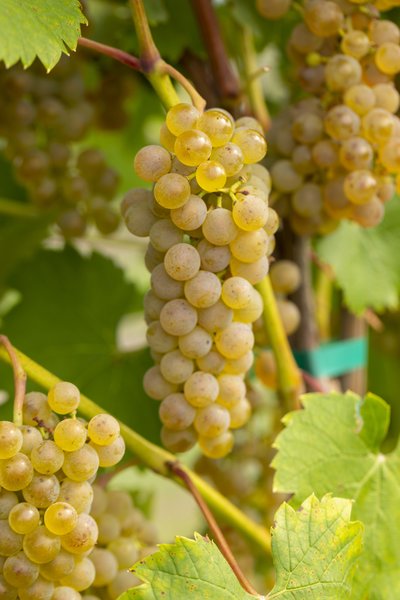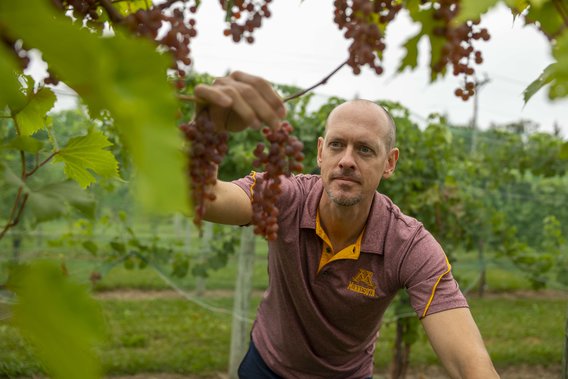
Grape Expectations!
From the vine to the glass — delicious wines from UMN Itasca grapes debut this season
Minnesota wine lovers, raise your glasses! This season, wines made from the University of Minnesota’s (UMN) newest cold-hardy wine grape, ‘Itasca,’ are available for the first time for consumers, with more options coming next year.
This means autumn opportunities to savor white Itasca wines, which are medium-bodied with a beautiful golden hue and expected aromas and flavors including apple, quince, melon, citrus, pear, gooseberry, starfruit, honey and mineral.
Itasca wines are made from UMN’s Itasca grape variety, first identified as an elite seedling in 2009 and released for licensed nurseries to sell in 2017. Itasca grapes are the latest in a series of cold-hardy varieties developed by UMN that led to the budding wine industry in Minnesota and other northern climates.
The University is committed to creating demand for delicious, distinctive Minnesota wines, said Matt Clark, assistant professor of grape breeding and enology in the department of horticultural science at UMN’s College of Food, Agricultural and Natural Resource Sciences (CFANS), and UMN Extension horticulture specialist.
“With its low acidity and high sugar levels — coupled with its high resistance to common grape pests such as downy and powdery mildew and the insect phylloxera — Itasca is well-positioned to create a robust market for grape growers and help winemakers succeed,” said Clark.
Itasca has shown cold hardiness as far north as USDA’s Zone 4, and currently more than 100,000 Itasca grape vines have been sold to Minnesota and other Northern vineyards across the United States. It joins other cold-hardy grapes known as Frontenac, Frontenac Gris, La Crescent and Marquette, all developed by UMN.
Steve Smith, owner of Brickhaven Vineyards and Winery in Prior Lake, Minn., is one of the largest growers of Itasca grapes. “There’s no reason why Minnesota can’t be a premier producer of high quality wines, especially with the dedication and research we have in our backyard with the University of Minnesota. They’re providing the products for us to really engage that industry,” he said.
Grape expectations
UMN has put years of innovation, science and research into grape breeding, enology and wine evaluation with the goal of creating superior Minnesota wines. It is recognized as one of the top wine grape research programs in the country, dedicated to developing high quality, cold-hardy and disease resistant wine grape varieties.
The UMN wine grape breeding program began in the mid 1970s. In 2000, an enology lab and research winery opened at UMN’s Horticultural Research Center in Chaska, Minn. Today, more than 12,000 experimental vines are cultivated on 12 acres, and thousands of seedlings are produced each year using a diverse genetic base.
“Breeding a new grape like Itasca can take 10 to 15 years of painstaking work, including cross-pollinating plants by hand and cloning new seedlings from cuttings,” said Clark. “Our team uses high-tech research techniques, like DNA sequencing and mass spectrometry, to understand seedlings’ genetic makeup and fruit quality.”
UMN’s expertise in the latest advances in genetics, propagation, hybridization, cultivation and winemaking ensures the introduction of vines with superior performance in both the vineyard and the winery.
A winning wine industry
Working hand-in-hand with UMN grape breeding is the enology team, led by enology specialist Drew Horton, who conducts micro-scale wine-making and research wine-making trials and experiments with the cold-hardy grapes, producing numerous experimental wines from test cultivars each year.
“We’re focused on helping wineries by determining optimum processing methods for cultivars like Itasca, and we aim to benefit the Minnesota wine industry by providing local support for winemakers’ analytical, technical and educational needs,” said Horton.
UMN research and the development of cold-hardy grapes has played an instrumental role in building a strong Minnesota wine industry. The state is home to about 80 wineries, more than 60 of which currently produce wine. A UMN Extension report shows that Minnesota’s cold-hardy vineyards and wineries pumped more than $80.3 million into the state’s economy and supported more than 10,500 jobs in 2016.
“I feel that the University and the industry are one,” said Matt Scott, general manager of winemaking and viticulture at 7 Vines Vineyard and Winery in Dellwood, Minn. “Without the U of M’s grape production program and education system, we can’t move forward,” he said, noting that Itasca is “probably going to produce some of the highest quality white wines...coming out of the region in the next decade.”
Ask for Itasca
Wine enthusiasts can check out a list of wineries that have released (or will soon release) an Itasca wine and nurseries/vineyards selling Itasca vines and grapes. It is recommended that people check the establishments’ websites or contact the vineyard/winery/nursery directly to check on hours, availability and any COVID-19 restrictions.
More information about Itasca and other cold-hardy grape varieties can be found at UMN’s Minnesota Hardy website.
University of Minnesota College of Food, Agricultural and Natural Resource Sciences
The University of Minnesota College of Food, Agricultural and Natural Resource Sciences (CFANS) brings science-driven innovators together to discover hands-on solutions to global challenges. With 10 research and outreach centers across Minnesota, the Minnesota Landscape Arboretum, and the Bell Museum of Natural History, CFANS offers unparalleled experiential learning opportunities for students and the community.








